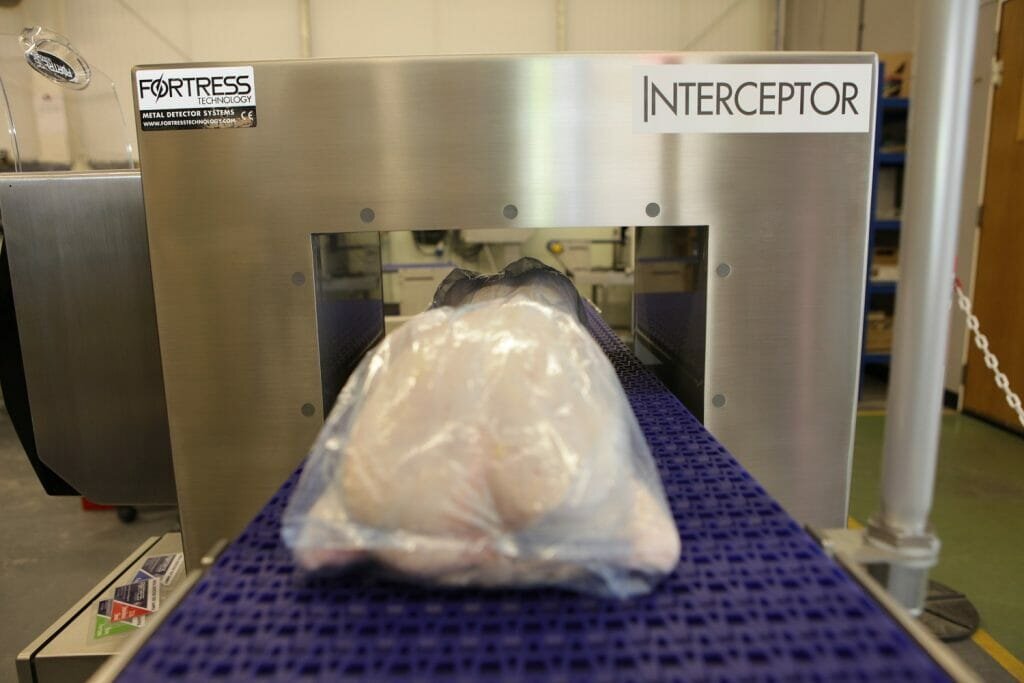Fortress Technology’s latest Food Safety First podcast zones in on foreign material control, including the sources and preventative measures that companies can take to stop contaminants of all types entering the food chain. Featuring renowned expert speaker and Vice President of AIB International, Jeff Wilson, together with Fortress Managing Director Phil Brown recap on the risks, facility considerations and technology features that form part of the total contaminant control picture.
Pest control, good manufacturing practices, machine maintenance, facility design and performing foreign material inspections at various stages of the supply chain are all steps that food manufacturers can take to prevent consumers biting into a foreign body. Yet, even the most robust processes are not infallible. In addition to well-documented contaminants, including stones, bones, pips, shells and stalks, extraneous materials introduced from equipment or packaging, or even the fabric of the facility itself, need to form part of a root cause analysis, highlights Jeff throughout the two-series podcast.
Given the numerous critical control points in a food manufacturing plant, Jeff advises taking a systematic approach to identifying potential food safety hazards. From identifying raw material hazards, having processes in place to isolate glass and ceramic packaging breakages, to recognising equipment and structural plant risks, the key he explains is to have detailed protocols in place that identify and then action these potential hazards.
Knowledge chain custodians
Although foreign material control is inherently process driven, if people aren’t trained to understand what could go wrong and what to look for, food integrity can still be compromised. Touching upon this in the podcast, Jeff explains: “Thankfully there is a high level of understanding about foreign material control across the food manufacturing sector. Yet often, inspection equipment can be tested by those who don’t always fully comprehend the inner workings of the technology.” Yet machines, if not understood fully, can also exacerbate food contaminant issues.
Knowing how to set and calibrate the machinery is one area that can be overlooked. This is where universal machine simplicity can help. As digitally ‘smart’ as Fortress Metal Detectors are, the company rarely deviates from its simple to use strategy explains Phil: “If a food processor is running a high-speed product line, our clients don’t really care how many megabytes per second the microprocessor inside is capable of handling. Quality managers simply want the detector to perform, reject contaminated product accurately, without incurring high levels of false rejects.”
To increase speed and ease of set up, plus eliminate human error, user-friendly features like automated single pass learning and calibration can deliver an accurate system set-up within seconds.
Environmental controls
Equipment interference is another common challenge that food manufacturers frequently misjudge, claims Jeff during the podcast. “During a food safety audit I frequently hear people express their disillusion in new inspection metal detectors. Usually it’s a simple thing. They haven’t factored in vibration and signal interference caused by industrial equipment radio signals and conveyors running in close proximity to their shiny new machine.”
To counteract this issue, a built-in noise immunity structure can dramatically reduce the effects of external electrical noise, again resulting in fewer false product rejects. This technology is built into the Fortress Bulk, as well as Fortress digital Metal Detectors and the new Raptor checkweighing series.

The development of the interceptor was inspired by the difficulty in inspecting “wet” products, including meat, dairy and bread
Pest preparedness
Equally important for food safety custodians is understanding which natural contaminants are more likely to be prevalent in harvested or raw foods. For example, pips, shells, stalks, bones, stones and insects. Upstream is often the best place to identify these contaminants. Although gravity metal detection inspection systems can be used, screening and sieving ingredients is more typical, particularly when trying to eliminate insects.
Taking flour as an example, Jeff emphasises the importance of sifting through a 600-micron screen to remove the smallest of insects. Additionally, changing a supplier, sourcing from a different country, or altering the process and product flow raises many other questions. Has your ingredient or product been sourced from the same country? Is it the exact same product your inspection system is calibrated to? Jeff notes that if the origin has changed, there might be a slightly different moisture or salt content.
In fact, any change, even between seasons can impact the product characteristics. To put this into context, Jeff observes that the protein levels in flour, for instance, can be different at the start of harvest compared to the end of the season.
Additionally, moisture levels, the air bubbles and density in baked bread can change minute to minute. Even in the same batch. This can impact a metal detector’s ability to distinguish between any metal contaminants that may have been introduced during the mixing process and the false signal given by the combination of product attributes. By conquering this product effect, the Fortress Interceptor Metal Detector can clearly differentiate between these signals and any metal contaminant.
Build a safety program
Overall, there are multiple steps a food manufacture can take to help control the introduction of foreign material into food products. Instilling a food safety culture and routine audits can help.
Both Jeff and Phil suggest a deep dive internal review of all food risks and processes at least once a month, including an inspection of everything from production lines and all machinery, to refrigeration and the outside roof. Jeff also advocates mixing people’s skills up and creating a truly multi-disciplinary team, including finance, engineers and quality control. He cites it as the ideal way to spread knowledge and embed an inspection culture that becomes natural.
Jeff ends the podcast with: “Nobody can do everything … But everybody can do something,” clarifying that everyone has a role to play in consumer and brand protection and keeping all contaminants out of the food supply chain.
For more details, listen to the free Fortress Technology food safety podcast series here https://www.fortresstechnology.com/food-safety-first-episode-5-part-2-foreign-material-control/





